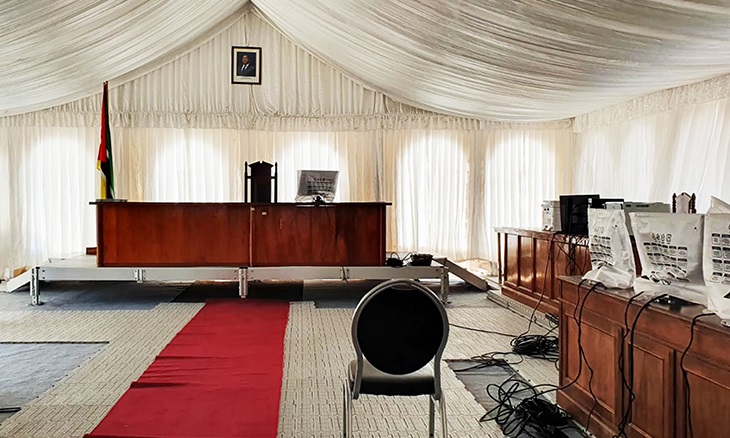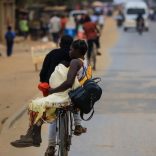Mozambique: Rainy season death toll rises to 313
Hidden debts: Massively corrupt scheme will be tried as from Monday – AIM report

Photo: O País
The definitive charge sheet from the Public Prosecutor’s Office against 19 people accused of involvement in Mozambique’s largest ever financial scandal gives exhaustive details of bribes paid by the Lebanon-based company Privinvest, and of the involvement of senior Mozambican government officials, particularly from the country’s security and intelligence service (SISE).
The fraudulent scheme involved setting up three security-linked companies, Ematum (Mozambique Tuna Company), Proindicus and MAM (Mozambique Asset Management). The companies eventually borrowed, in 2013 and 2014, over two billion US dollars from the banks Credit Suisse and VTB of Russia.
Loans on this scale to recently formed companies with no track record, and run by SISE, were only possible because government officials, notably Finance Minister Manuel Chang, signed loan guarantees – pledging that, if the companies did not repay, the Mozambican state would be liable.
All three companies are now bankrupt, and the country’s highest court, the Constitutional Council, has declared the loans and their guarantees unconstitutional. But that does not stop the creditors from demanding their money back.
The case comes to trial in Maputo on Monday, and the trial is expected to last for at least 45 days. But not all the key figures will be in the dock – Chang himself has been under police custody in South Africa since December 2018, while the Justice Minister, Roland Lamola, decides whether to extradite him to Mozambique or to the United States.
The three corrupt bankers from Credit Suisse, who arranged the loans in exchange for huge bribes from Privinvest, are also not showing their faces in Maputo. Andrew Pearse, Detelina Subeva and Surjan Singh, when before US prosecutors, all admitted to taking bribes as part of plea bargaining. But they have not yet been sentenced.
The Privinvest official who distributed the bribes, Jean Boustani, is also avoiding Mozambican justice after he was acquitted in New York in 2019 when smart lawyers convinced a jury, quite wrongly, that the US court did not have jurisdiction in the case.
While the loans and their guarantees were ruinous for Mozambique, they were very good business for Privinvest, which became the sole contractor for the three fraudulent companies, providing them with boats and other assets at vastly inflated prices. According to the 2017 independent audit of Proindicus, Ematum and MAM, Privinvest overcharged Mozambique about 713 million dollars for equipment of dubious value.
But, initially, it was not clear that the Privinvest scheme would win Mozambican political approval. So, according to the prosecutors, one of the Mozambicans working on the project, Teofilo Nhangumele, contacted his old friend Bruno Langa, a SISE officer, to ask how to unblock matters.
Langa turned to his friend and business partner, Ndambi Guebuza, the oldest son of the then President, Armando Guebuza. He agreed, provided he received adequate “thanks”. He took the project to his father, who did indeed give the green light. Then the bribes began to flow.
The largest bribe paid by Privinvest was 33 million US dollars, paid to Ndambi Guebuza, the prosecution says. The money was paid, partly into an account he had opened in the Abu Dhabi Commercial Bank, in the United Arab Emirates, and partly via various South African companies.
The first major payment from Privinvest was for 14 million dollars, deposited on 26 March 2013, in Guebuza Junior’s Abu Dhabi account.
In order not to alert the Mozambican financial authorities to what was going on, Ndambi Guebuza opted to use South African companies as middlemen. Hence on 18 June 2013, Privinvest transferred 2.55 million rands (about 167,000 US dollars, at current exchange rates) to the account of the law firm Jouberts Attorneys in South Africa’s First National Bank (FNB).
The money was then used to acquire real estate, automobiles and for other expenditure. Thus Guebuza Jr acquired one property in South Africa for 11.6 million rands, and 2.9 million rands were transferred to the company Imperial Collection, which trades in luxury cars.
On 17 June 2013, Privinvest transferred a further 700,000 dollars to Jouberts Attorneys, at Guebuza’s request. That money was used to buy a Ferrari luxury sports car.
Privinvest then, on 23 April 2014, transferred 10.5 million rands to the South African company Pam Golding Properties. Ndambi Guebuza used this money to buy at least 15 vehicles in South Africa, some for himself and some to offer to friends. None of this had anything to do with coastal protection or tuna fishing, the supposed purposes of the Credit Suisse and VTB loans
The Mozambican prosecutors, sifting through Guebuza Jr’s financial records, drew up a long list of people and companies who received some of the Privinvest money. Among these was a transfer Guebuza Jr ordered of seven million rands from Pam Golding Properties to Apple Creek Real Estate Trust. The latter company received instructions from Ndambi to transfer three million rands to a second law firm, Nochumsoth Teper Attorneys, to buy a property for his sister, the late Valentina Guebuza.
In order not to alert the South African financial authorities, this payment was broken into three parts, each for a million rands.
Teofilo Nhangumele and Bruno Langa each received 8.5 million dollars from Privinvest. The prosecutors found that the two men used the bribe money to buy properties, luxury cars and livestock, among other expenditure, inside Mozambique and abroad.
Nhangumele will be among the first defendants to be heard on Monday. Before Nhangumele, the court will question Cipriano Mutota, the former director of the Studies and Projects Office of SISE. The prosecution says he received bribes of 980,000 dollars from Privinvest. He was the SISE officer who received the Privinvest proposal (supposedly for the protection of Mozambique’s Exclusive Economic Zone) via Nhangumele.
Both Nhangumele and Mutota face charges of corruption, abuse of trust, money laundering and membership of a criminal association.
The prosecution is asking the court, in addition to any custodial sentence, to order the defendants to pay compensation to the Mozambican state of 2.9 billion dollars.
That sum is not enough. The loans themselves were for about 2.2 billion dollars. But since they were contracted, the costs for Mozambique have spiraled upwards.
In a detailed study published in May, the anti-corruption NGO, the Centre for Public Integrity (CIP) calculated that the “hidden debts” have already cost the country at least 11 billion dollars, and have plunged an additional two million people into poverty.
The CIP report puts the direct cost of the loans so far incurred, up to and including 2019, at 674.2 million dollars, in payment of interest and capital. If Mozambique is obliged to go on servicing the debts, there will be an additional 3.93 billion dollars to pay up to 2031.
But the indirect costs of the scandal are much higher. The secrecy and corruption surrounding the loans dealt devastating blows to Mozambique’s credibility and reputation.
The report notes that “When rumours about hidden loans began to circulate, Mozambican ministers lied to the IMF and ambassadors of Mozambique’s development partners, denying the existence of any loans. When the Wall Street Journal revealed the hidden debt in April 2016, the anger was extreme. Donors and lenders had kept the country afloat, and they pulled the plug”.
The International Monetary Fund (IMF), angered that the Mozambican government had concealed the true size of its foreign debt, suspended its programme with Mozambique in April 2016. All the 14 donors and funding agencies who had provided Mozambique with direct budget support, suspended further disbursements, and to this day, more than five years later, they have not resumed.
The loss of this foreign aid in 2016 cost Mozambique 831 million dollars, in comparison with 2015, and these losses have continued to cascade down the years.
The CIP report notes that the ensuing financial crisis meant that “the government became unable to pay its bills, there was a major currency devaluation, foreign debt became unpayable, the economy slowed down sharply, real GDP per capita fell, unemployment soared and poverty increased”.
The report puts a figure on this damage. It calculates the fall in the value of Mozambique’s GDP at 10.7 billion dollars between 2015 and 2019. This is a loss that cannot be recovered, and it will continue to grow, year after year.
The report puts the total economic losses over this four year period at 11.33 billion dollars – or a loss of 403 dollars for every man, woman and child in the country.
The report noted that “the sudden rise in inflation in 2016 and rising prices drove 2.6 million people below the threshold of consumption-based poverty”. It estimates that, because of the hidden debt scandal, at least 1.9 million people had fallen below the consumption-based poverty line by 2019.
The prosecutors have been tracking all the bribes paid by Privinvest, leading to the discovery of more goods purchased with the bribe money, and more bank accounts. Although the properties can be seized, the money raised in this way comes nowhere near meeting the true costs of the scandal.













Leave a Reply
Be the First to Comment!
You must be logged in to post a comment.
You must be logged in to post a comment.